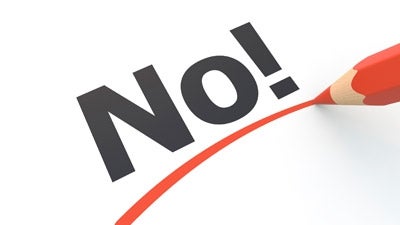
As an entrepreneur, I’ve made a life for myself by taking and embracing risk. I am the first to understand that no business is possible without risk, but at the same time, not all risk is good for business. In the entrepreneurial world, I think there is a common assumption that no client partnership is too great, too enormous, or too complicated to turn down.
Not to burst anyone’s bubble, but this isn’t always true.
The ability to say “No” to a potential client is just as, if not more, important as saying “Yes.” (It doesn’t help that saying “No” is much, much more difficult than saying “Yes.”)
I get that incoming projects are important for your business, especially if you are service-based. My own business depends on having clients who need our expertise. But there are plenty of reasons why on-boarding some clients can harm more than help your business, leading to insane hours and headaches.
Scenario 1: The client makes you deviate from your business principles.
There are business principles for just about everything, whether you are developing stellar websites, baking the best desserts in town, or building custom homes. Everything has a standard. This is not to say that practices cannot change—that would be called flexibility. But when a client is asking you to deviate far away from your standards, it might be time to say “No.”
A couple of years ago, I was working with a client who wanted nothing short of the world, with a few planets tacked on as well. It is one thing to accommodate the client’s needs, a very important part of any client relationship. Having to constantly bend backwards made my trusted process slow and ineffective, which caused tension between my business and the client, halted other ongoing projects, and wasted my team’s time. Eventually, after months of stagnant process I decided to let the client go.
Scenario 2: The client has a bad attitude and is not willing to on-board.
I’ve run the gamut of different types of clients. By far, the best kinds of clients are the organized, helpful self-starters who have a penchant for punctuality. But every now and then, you have those clients who, to put it lightly, are not excited to be working with you.
Sometimes strain is a result of the client not understanding your process. In this situation, do your best to educate them. Right now, I’m working with a potential client who has shown anxiety towards the project. Instead of axing the deal completely, I am doing all I can to educate and alleviate any worries they may have. If this doesn’t work, it might be time to reassess and move on.
Scenario 3: You are not fully equipped to meet the client’s needs.
No one likes to admit they do not have the aptitude or capability to take on a project. But no one likes to look like a sham, either. When thinking about on-boarding a new client, this is something to consider.
When I go over RFPs, I have to be honest with myself. Can I meet these needs? Can I meet these needs successfully? Will this client and their project turn into a time-drain that I can’t afford? Honesty is one of the most important qualities to have as a business owner. If you take on a project, botch it up because you were ill prepared, and then get bad feedback, the fault lies with you. Know your limits.
Not every client will be a ball of sunshine. Trust your instincts and use your keen discretion when evaluating what projects are and are not a good fit for your business. After all, not all projects will be a match made in heaven.
This article was originally published by Under30CEO
Author: Ab Emam is the Founder and manages the day-to-day business operations at WDG, The Web Development Group, Washington, D.C.’s premier full-service creative web agency.
Published: November 10, 2014
2132 Views
2132 Views











